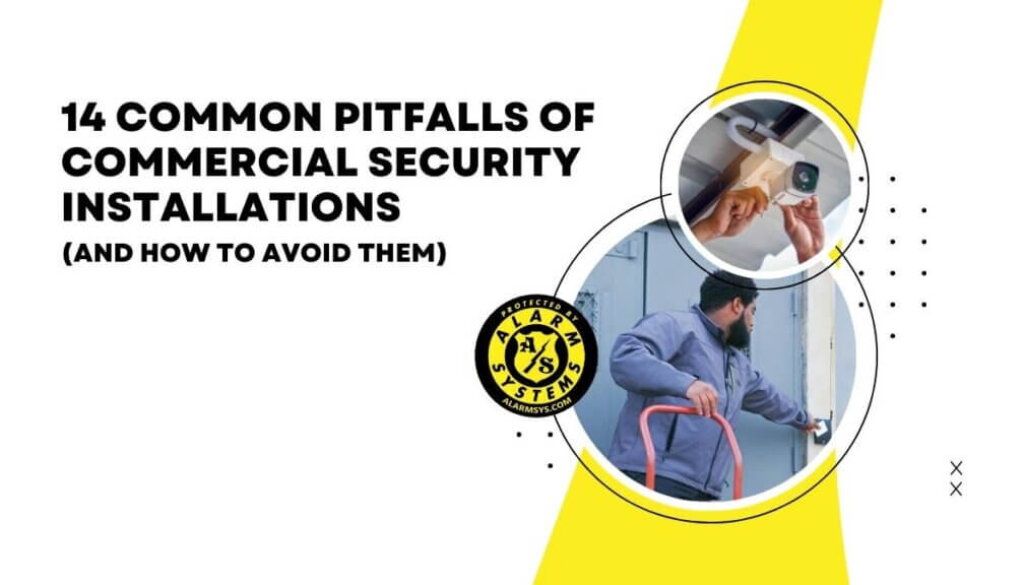14 Common Pitfalls of Commercial Security Installations (And How to Avoid Them)
Ensuring robust security for your business involves far more than simply installing cameras and alarms. Many organizations unknowingly fall into common pitfalls, severely compromising their security efforts. These pitfalls, when overlooked, can lead to security breaches, financial loss, and reputational damage. Here’s an in-depth look at these common mistakes and how you can avoid them.
TL:DR: Listen Here
Ignoring Comprehensive Risk Assessment
Businesses frequently underestimate the value of a comprehensive security risk assessment. Without a detailed evaluation, critical vulnerabilities can remain undetected, potentially leading to security breaches or theft. For example, a manufacturing plant may overlook securing secondary entry points, mistakenly focusing only on main entrances.
Engaging professional security experts to perform a thorough evaluation of your premises identifies vulnerabilities related to theft, unauthorized access, internal fraud, or even natural disasters, allowing you to implement precise protective measures tailored to your business needs. Regular reassessment as your operations grow or change ensures ongoing protection and adaptability to evolving threats.
Choosing Cost Over Quality
Budgetary concerns often prompt businesses to select the cheapest available security systems, which can lead to significant issues down the line. Low-cost security devices are often less reliable, producing poor-quality footage or frequent false alarms, reducing overall effectiveness.
Consider a convenience store that chooses inexpensive cameras only to realize they provide blurry images during incidents, making identification difficult or impossible. Investing upfront in quality products from reputable brands ensures better reliability, clearer footage, and fewer system malfunctions, and ultimately reduces long-term costs associated with repairs or replacements.
Poor Camera Placement
Incorrect or haphazard camera placement often results in significant blind spots or ineffective surveillance. Cameras must be strategically positioned to monitor key entry points, high-value asset areas, and common paths of entry or exit. A logistics company, for instance, that only places cameras at loading docks but not inside warehouses may fail to detect internal theft, leading to considerable financial losses.
Engaging a security professional can help ensure optimal camera placement, maximize coverage, enable effective monitoring, deter criminal activity, and improve incident response and investigation capabilities.
Neglecting Access Control Integration
 Many businesses install standalone access control systems without integrating them with other security measures such as alarms or CCTV. This lack of integration can result in slower response times during security breaches and reduced operational efficiency. For instance, an office building operating separate systems for door access, alarms, and video surveillance might struggle to respond swiftly and effectively during emergencies. Integrating these systems into a unified security management platform provides seamless operation, streamlined monitoring, rapid response capabilities, and enhanced reporting, significantly improving overall security management.
Many businesses install standalone access control systems without integrating them with other security measures such as alarms or CCTV. This lack of integration can result in slower response times during security breaches and reduced operational efficiency. For instance, an office building operating separate systems for door access, alarms, and video surveillance might struggle to respond swiftly and effectively during emergencies. Integrating these systems into a unified security management platform provides seamless operation, streamlined monitoring, rapid response capabilities, and enhanced reporting, significantly improving overall security management.
Overlooking Cybersecurity
With increasing digitization, overlooking cybersecurity in physical security installations can expose businesses to severe cyber threats. Unsecured network-connected devices, such as cameras or smart locks, can become entry points for cyber attackers, potentially exposing sensitive business information and compromising physical security.
A healthcare facility with networked security devices that are not securely configured could experience breaches exposing patient data or compromising operational continuity. Employing robust cybersecurity protocols, regular software updates, secure networks, strong password management, and employee training on cybersecurity best practices helps mitigate such threats effectively.
Lack of Professional Monitoring
Businesses relying solely on internal security management without professional monitoring risk inadequate responses to incidents, particularly after business hours. For example, a retail store relying solely on self-monitored systems might miss critical overnight alarms, delaying response and increasing losses from burglaries or vandalism.
Professional 24/7 monitoring services provide continuous oversight, immediate detection of incidents, and rapid notification of emergency services, significantly enhancing your business’s ability to mitigate damage quickly and effectively.

Inadequate Training for Staff
Effective security relies heavily on employees who understand their roles within the broader security strategy. Insufficient training can result in staff mishandling security incidents or failing to follow established security protocols properly. For example, hotel employees inadequately trained in responding to alarms might disable critical systems, misunderstanding a genuine threat as a false alarm. Implementing ongoing training programs that clearly communicate security protocols, equipment usage, and emergency procedures ensures staff are prepared, significantly enhancing overall security preparedness.
Ignoring Regular Maintenance
Regular maintenance of security equipment is essential to ensure continuous, reliable operation. Neglecting scheduled maintenance can cause unforeseen system failures, leading to severe vulnerabilities precisely when security is most critical. A restaurant failing to routinely service its security cameras and alarms could experience system failures during peak hours, allowing theft or unauthorized access to go undetected.
Establishing routine maintenance schedules conducted by qualified technicians prevents unexpected system downtime, ensuring your security systems remain fully functional and reliable when needed most.
Underestimating Storage Needs
Adequate video storage capacity is frequently underestimated during system planning, resulting in insufficient retention periods for essential footage. For example, a retail store might not realize storage is limited until critical footage needed to investigate a theft is overwritten or unavailable, complicating incident investigations. Anticipating storage requirements and installing scalable solutions ensures that you can retain essential video evidence for sufficient durations, supporting both security operations and compliance obligations, such as regulatory requirements or insurance claims.
Not Incorporating Proactive Video into the Security Design
Traditional video surveillance is primarily reactive, meaning it records events for review after an incident occurs. However, proactive video surveillance incorporates real-time analytics and smart technology to detect suspicious activities as they happen, allowing immediate intervention. For example, a large automobile dealership could greatly benefit from proactive video analytics that alert security staff when someone approaches vehicles after hours, potentially preventing vandalism or theft. To maximize your security investment, integrate proactive monitoring solutions that include intelligent motion detection, intrusion alerts, and remote video verification.
Not Considering a Fully Integrated Security and Automation Platform
 Using separate, standalone security systems can result in fragmented management, delayed responses, and operational inefficiencies. A fully integrated security platform consolidates video surveillance, access control, alarm systems, and building automation (such as lighting and thermostats) into a single, user-friendly application. Imagine a large commercial property management firm operating multiple facilities; without integration, responding quickly to incidents or managing systems across locations can become cumbersome and ineffective. Choosing a fully integrated solution enables centralized control, enhanced situational awareness, streamlined operations, and quicker response times.
Using separate, standalone security systems can result in fragmented management, delayed responses, and operational inefficiencies. A fully integrated security platform consolidates video surveillance, access control, alarm systems, and building automation (such as lighting and thermostats) into a single, user-friendly application. Imagine a large commercial property management firm operating multiple facilities; without integration, responding quickly to incidents or managing systems across locations can become cumbersome and ineffective. Choosing a fully integrated solution enables centralized control, enhanced situational awareness, streamlined operations, and quicker response times.
Not Choosing a Company with CANASA-Trained, Background-Checked Technicians
Security system installation and maintenance involve highly sensitive tasks. Technicians with insufficient training or questionable backgrounds pose substantial risks to businesses. Hiring companies that don’t ensure their technicians are certified through reputable organizations like CANASA (Canadian Security Association) or thoroughly background-checked increases vulnerabilities. For instance, an organization hiring uncertified contractors might unknowingly expose confidential security details or critical business information to individuals with criminal backgrounds. Always partner with companies employing CANASA-trained and rigorously vetted technicians, ensuring safe, secure, and trustworthy service.
Not Incorporating Adequate Lighting into Video Surveillance Designs
Effective lighting is crucial for optimal performance of video surveillance systems. Even high-quality cameras with infrared capabilities can only provide limited visibility in low-light or nighttime conditions, resulting in reduced image clarity or grainy footage. Businesses often underestimate the importance of adequate lighting around entry points, parking lots, or loading docks, inadvertently creating opportunities for undetected criminal activity. For example, a storage facility that relies solely on cameras without sufficient lighting may fail to clearly identify suspects or license plates during incidents. Incorporating ample lighting into surveillance plans significantly improves video quality, deters criminal activity, and enhances overall safety and security.
Not Planning for Scalability
Security systems must adapt as your business grows, but failing to plan for scalability can lead to costly and disruptive system replacements. For instance, a rapidly growing startup initially choosing a basic, non-expandable system may later face significant expenses and operational disruptions when needing to expand or upgrade.
Choosing scalable security solutions from the outset, such as modular equipment or systems capable of easy integration with additional devices, allows seamless growth. This approach helps avoid significant future expenses and ensures your security infrastructure can flexibly adapt to future demands.
Avoiding these pitfalls involves proactive planning, selecting high-quality solutions, and leveraging professional expertise.
If any of these pitfalls sound familiar or you want a professional evaluation of your current systems, contact us for a no-obligation security audit of your facility. Our experienced team specializes in assessing vulnerabilities and implementing tailored, scalable solutions specifically for your business.
Secure your business the right way—today.




